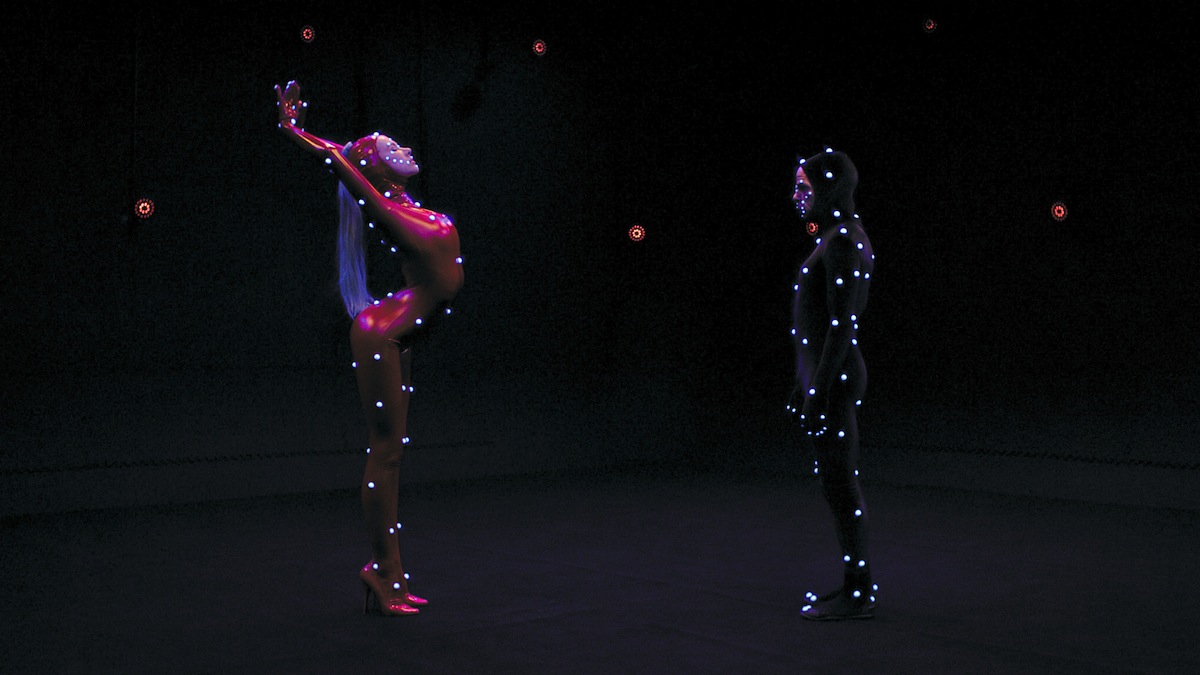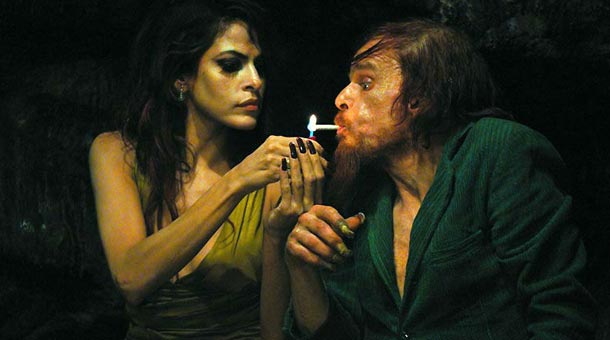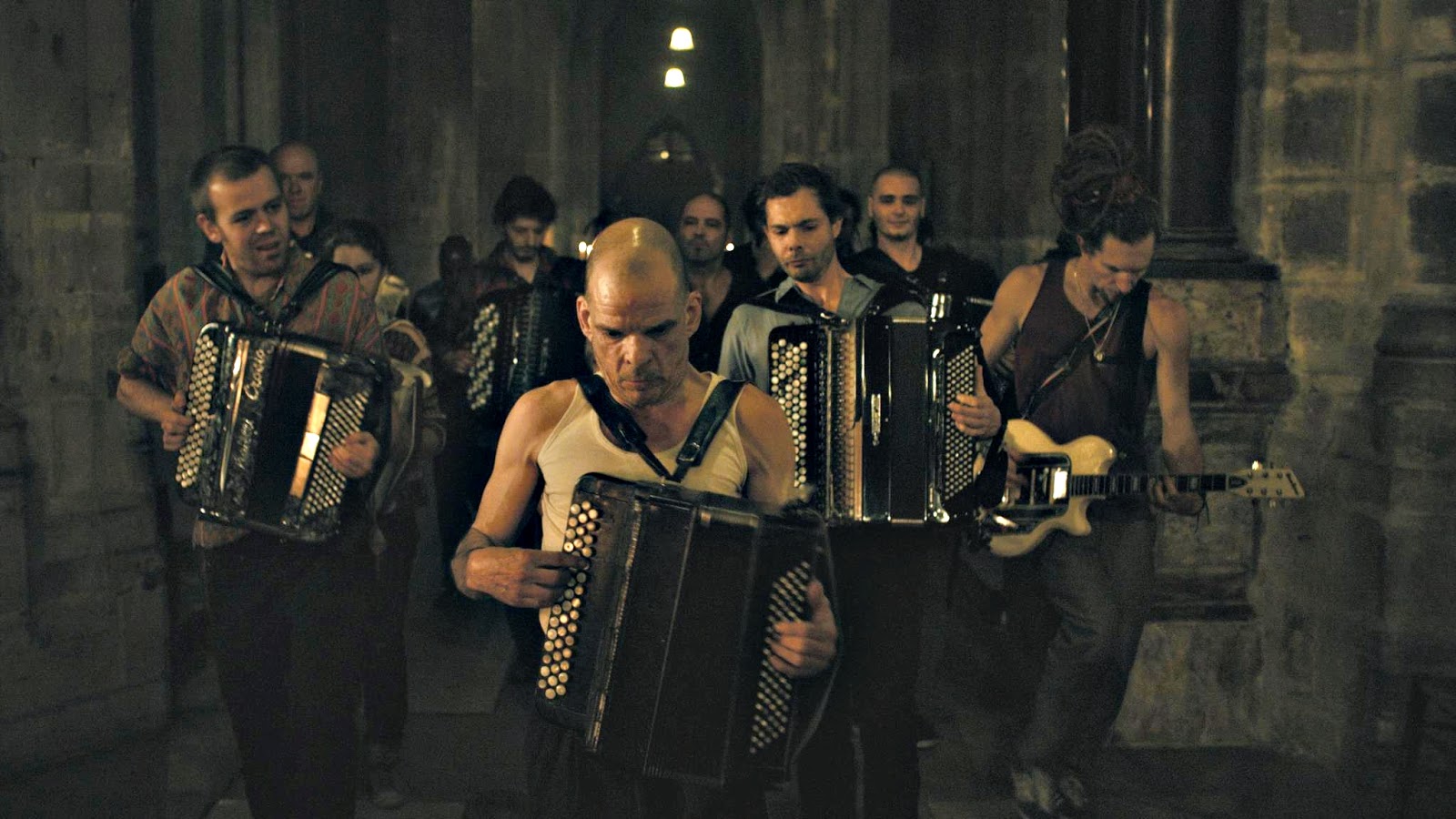4. Social Critique about Virtual Reality

From an anarchist approach, surrealists assault cultural institutions – religious organizations, political systems, socioeconomic ideologies, etc. – through innovative, and oftentimes shocking artistic expression in order to dismantle their authority. Although not as aggressive but just as imaginative, Holy Motors’ shrewd social critique tackles virtual reality and how it is imposed on the public, identity as a slippery concept in the Digital Age and the shifting importance of the actor in today’s industry.
In case of the latter, even with computer animation’s prominence in the film industry, the actor remains a key part to the process. Returning to the motion capture scene, Oscar physically enacts an unseen director’s instructions such as running and shooting a gun as well as has simulated sex with an agile, serpentine contortionist.
The close-up shots call attention to both actors’ performance – the choreography, boldness, and authenticity – just before showing the mo-cap computer animation. Not only does the scene point out that the animation is dependent on the actor’s motion tracking, but the camera language makes the animation pale in comparison to the captured performances.
However, being isolated in a pitch-black soundstage, almost unrecognizable in their spandex suits, the actor’s identity seems to be dissipating, subsisting under obscurity throughout Holy Motors. Alongside other actors, Oscar is disillusioned at the lack of presence by the absence of traditional cameras, yet he continues to perform under the impression that small, unseen cameras are recording him.
Whether it’d be Oscar and Jean (Minogue) asking each other if their hair and eyes are their own or someone else’s, the stretch limousines’ fear of being replaced, or a cemetery filled with tombstones that have “visit my web site” written on them, Holy Motors expresses skepticism towards digitalized media’s imposition on daily life, and underlines the prospect of an invisible industry’s absorption of individuality.
On the other hand, “Motors” shows confidence that actors will remain active by helping shape the quality in the industry despite the probability that the exact conditions of their work are liable to change.
5. Mad Love and the Search for Truth in Falsity

Riding the stretch limousine, a nameless man with a port-wine stained asks Oscar what motivates him to keep performing, to which the professional shape-shifter nonchalantly replies, “What made me start, the beauty of the act.”
This kind of obsessive pursuit to achieve an abstract object is what surrealist chief André Breton referred to as “mad love,” an intense, if not self-destructive love or desire that violates logic.
If Holy Motors is about how an individual’s course is shaped by a cosmic power to become the person he or she is now, then it is Oscar’s drive to enact beauty that has defined every other aspect of his life. On the other hand, this mad love also leads characters to epiphanies or realizations they would not have been to reach otherwise.
When the stranger contends, “Beauty? They say it’s in the eye, the eye of the beholder,” Oscar retorts, “and if there’s no more beholder?” Hence, Oscar believes that beauty exists even without an audience, that his performance is of value even without a camera there to confirm it. In this manner, Holy Motors pursues truth in falsity, in what cannot be perceived by the senses.
Although it reaches this conclusion halfway through the film, Holy Motors keeps exploring its protagonist’s illogical pursuit. Volatile, misunderstood and as it is evident at the outcome of his encounter with Jean, prone to disaster; Oscar appears to be in an emotionally deteriorating state that only grows worse.
Once again, Oscar becomes an elliptical contradiction: he knows there is beauty outside empiricism or perception that he must continue to keep enacting, but each day’s repetitiveness gradually lessens his chances. The last time we see Oscar, he is overlooking through his house’s window, alongside his “wife” and “child,” both chimpanzees.
This absurd image is emblematic of Oscar’s enslavement to his own mad desire, at the rift of repeating the cycle the next day, and whose isolation is all the more apparent when compared to the apes’ ignorance.
6. Holy Motors as a Microcosm of Cinema

Reunited after 20 years, Oscar and Jean walk through the Samaritaine building ruins, a once prosperous department store. Suddenly, Jean sings about “who were we when we were, back then? / Who would we have become if we’d done differently back then?” A romantic musical piece that mourns, yet celebrates a sense of wonder that belonged to earlier times. In many ways, this scene crystalizes how Holy Motors pays tribute to cinema.
After its inception in the 1920s, Surrealism became the first movement whose artistic pursuits aligned with cinema’s. From Buñuel’s Un Chien Andalou and Dulac’s The Seashell and the Clergyman to Lynch’s Mulholland Drive, the film medium offers the necessary freedom to become the ideal vessel to materialize surrealist language. However, Holy Motors does the opposite: it employs and applies Surrealism traditions to the film medium in order to encapsulate cinema.
Without losing its connective tissue as a self-contained narrative, Holy Motors’ episodic vignettes grant the elasticity to travel to different genres – gangster film, musical romance, deathbed melodrama, domestic drama, monster horror and so on – that by sharing the lead performer, strengthens the quality of genre as staged performance.
Furthermore, “Motors’” multi-dimensional mosaic portrays cinema diachronically by encompassing Eadweard Muybridge’s stop motion films from back in the 1870s all the way to today’s motion sensor technology.
More idiosyncratically, Holy Motors pays tribute to Carax’s long-standing collaborator Lavant as well as his roles (Boy Meets Girl, Mauvis Sang, The Lovers On the Bridge, and the “Merde” segment of the anthology film Tokyo!). Other familiar images include Scob wearing the same mask she wore in Franju’s Eyes Without a Face (1960), Minogue’s hairstyle’s resemblance to that of Jean Seberg’s in Godard’s Breathless (1960), and Carax’s earlier works such as The Lovers On the Bridge (1991).
In tune with Surrealism, Holy Motors does not aim to “reference” other films (an interpretation that Carax would look down upon), but to create a cinematic language that speaks of a foreign self-contained world whose reality is synonymous with cinema. Paradoxically, Holy Motors is not about cinema, as the statement would condition they are two separate entities that coexist through referential treads, but on the contrary, “Motors” is an experience in cinema as territory.
In her song Jean laments, “There was a child, a little child / We once had a child,” now presumably lost, but hoping she could someday regain. Similarly, Holy Motors testifies of an inner yearn to someday rediscover that wonder once again.